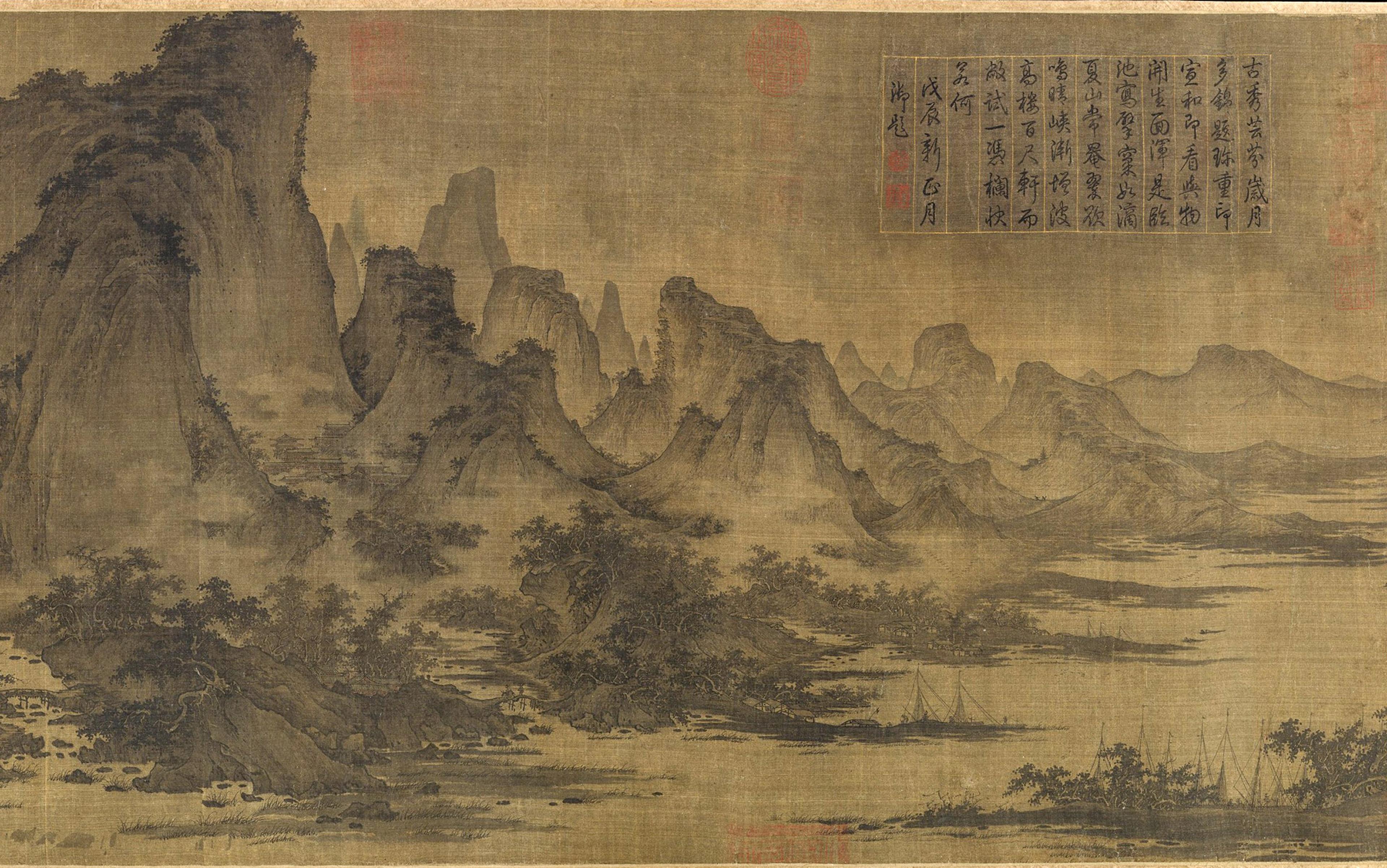In 1676, the Qing navy engaged a fleet of the Zheng kingdom, a trading empire based in Taiwan that controlled sea lanes from Japan to Southeast Asia. Despite regarding the Zheng state as little more than a pirate organisation, a Qing captain had to respect the size of its fleet, describing its ships as ‘uncountable, we saw only masts like a forest.’ Others have written at length and in detail on the political and military aspects of the Qing-Zheng war. To me, the sheer scale of this naval battle requires us to pay attention to other places far from the coast and, indeed, to other species entirely. After all, the trees that ended their lives at the bottom of the Taiwan Strait began their lives in the mountains of southern China and Taiwan. Some had been planted by human hands mere decades before they were felled, others had fallen as seeds below their ancient ancestors, and themselves grown into multi-century-old giants before suffering two deaths – the first by axe, the second by cannonball.
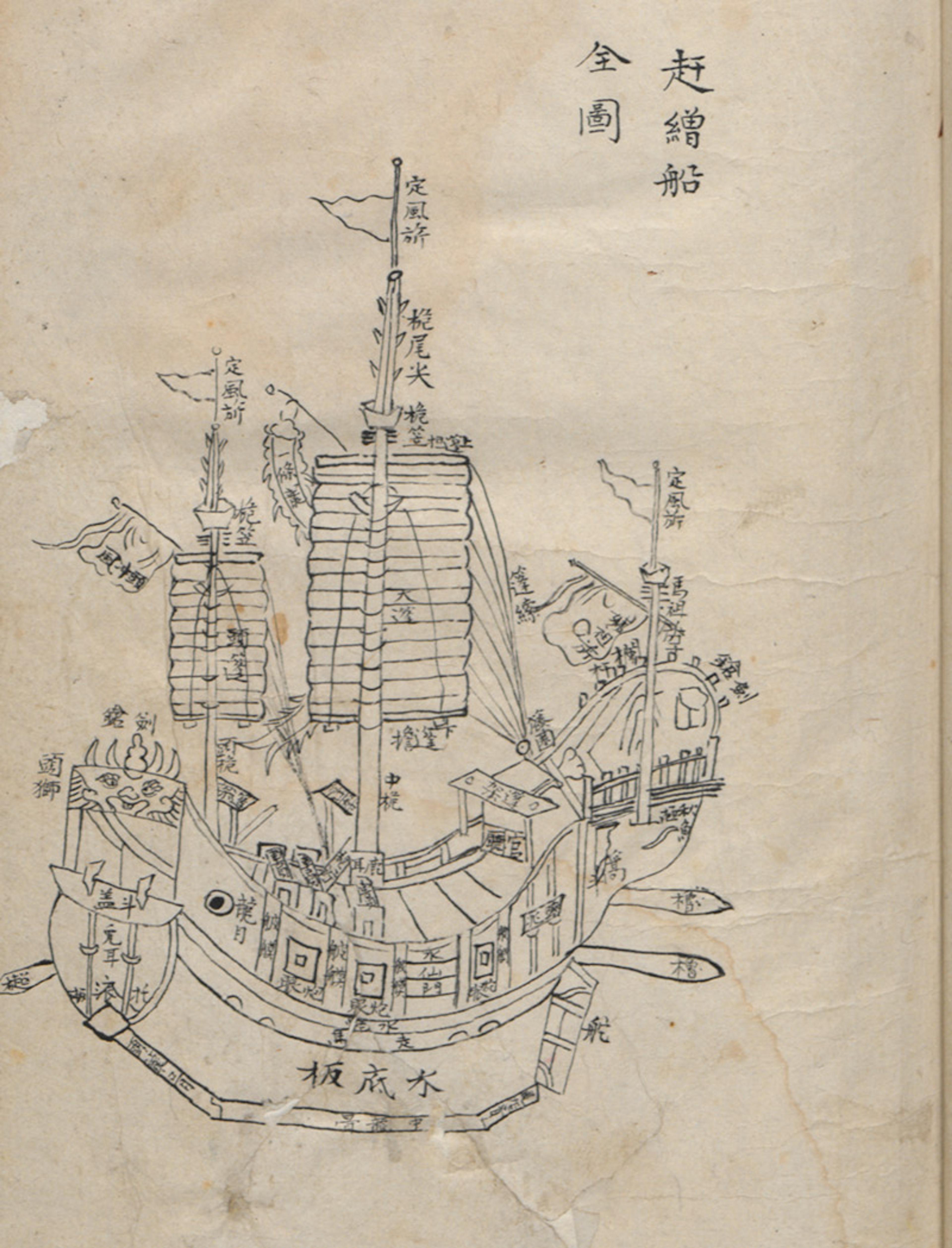
A standard Qing warship. Images courtesy the Staatsbibliothek, Berlin
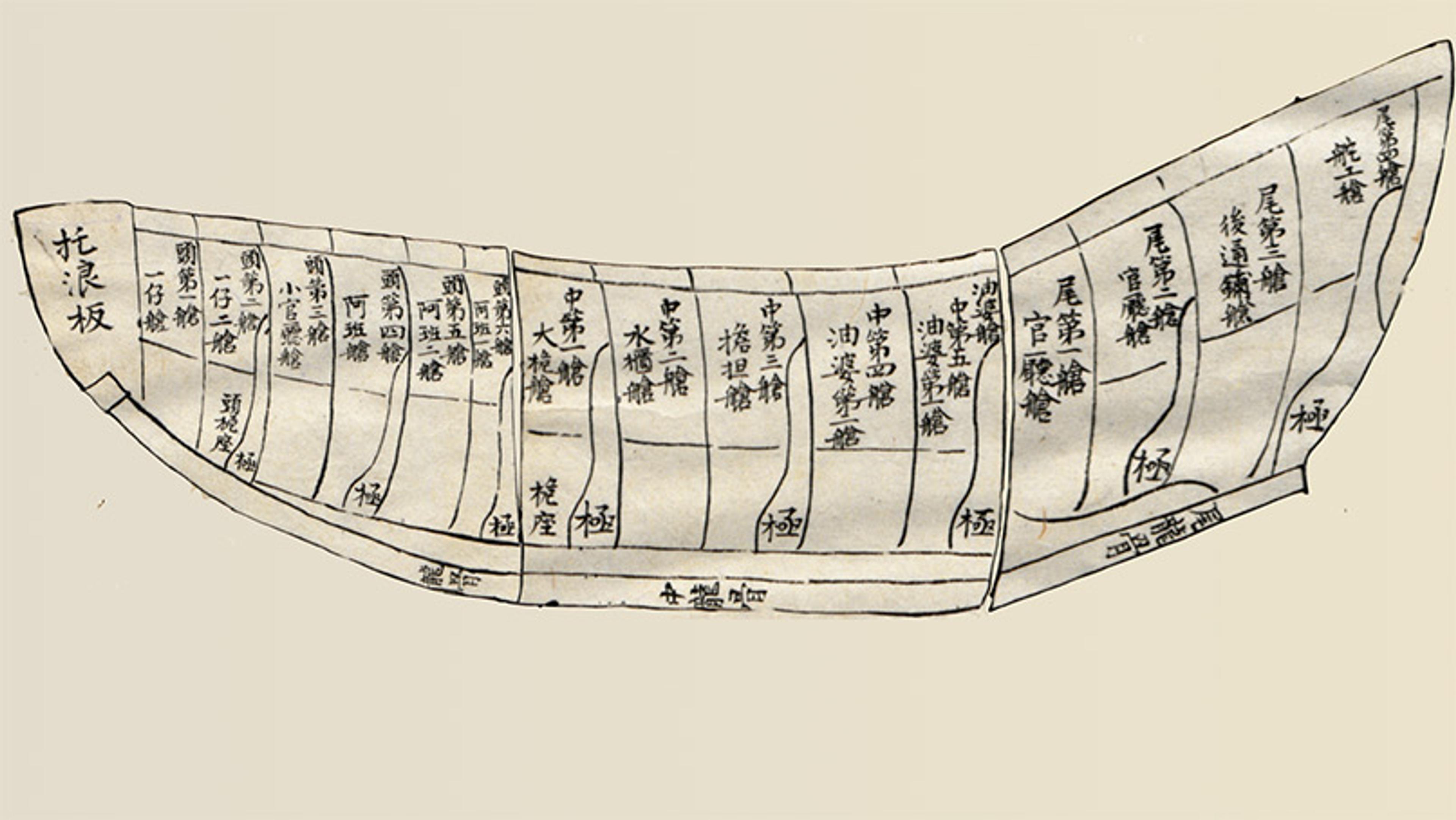
Naval timber was a strategic good in 1676, and for centuries before and after. In this era before widespread use of coal and oil, before uranium, lithium and cobalt, governments needed wood for nearly everything: firewood and charcoal to fuel smelters; timber for temples and palaces, shops and factories, bridges and dikes; but, most of all, they needed wood for ships. In an age of sail – of growing trade and explosive episodes of naval warfare – ships were necessary for exchange, defence and power projection. Exposed to repeated cycles of wetness and dryness, their hulls rotted rapidly; their masts and spars were often damaged in storms or battle; and because they were used under dangerous conditions, many ships ended up at the bottom of the sea. Finding new trees, large trees, with the right structural characteristics to make rot- and cannon-resistant hulls and replace storm-damaged masts and spars was a constant concern.
Yet, as shipbuilders understood, naval timber was not a single commodity. A proverb recorded in the early 20th century reflected this reality: ‘To build a ship to last for son and grandson, [use] fir, cypress, catalpa, camphor and nanmu’ (it rhymes in Chinese: yao zao zisun chuan, shan bai zi zhang nan; 要造子孫 船、杉柏梓樟楠). Timbers were delineated to different uses based on their structural characteristics. In 16th-century Nanjing, government ships were built primarily of fir and nanmu – both species used for planking and masts. In Guangdong, some ships were hulled with ironwood – a tropical wood as hard as its name suggests. In 18th-century Fujian, warships had fir hulls; cabins and rails of camphor; a paper mulberry rudder; and a miscellany of smaller components built of various other species. But for almost all these components, the do-everything wood was China fir – a fast- and straight-growing conifer that is relatively resistant to both rot and insects, and that was used for everything from hull planking to masts.
Regardless of the tree species, shipyard officials used fundamentally similar procedures to turn each log into standard-sized components. By the late 1540s, the Ming shipyards in Nanjing established standard sizes for planking – one Chinese pole (zhang; 丈) by one Chinese foot (chi; 尺) by one Chinese inch (cun; 寸) – approximately 3 metres by 30 cm by 30 cm. They worked with customs officials to mark these logs before they even reached the shipyards. To make processing easier, each incoming log was branded with one character for each foot in circumference. Officials compiled tables for how many standard boards could be cut from each log of a given dimension. If logs came from trees that had not grown absolutely straight – with hollows, bends, knots or twists, all flaws in the eye of the carpenter – they were discounted in proportion to how many boards were lost. Some timber merchants even contracted to provide the large timbers required for masts and spars as a package, including one six-foot log, three five-foot logs, and three four-foot logs.
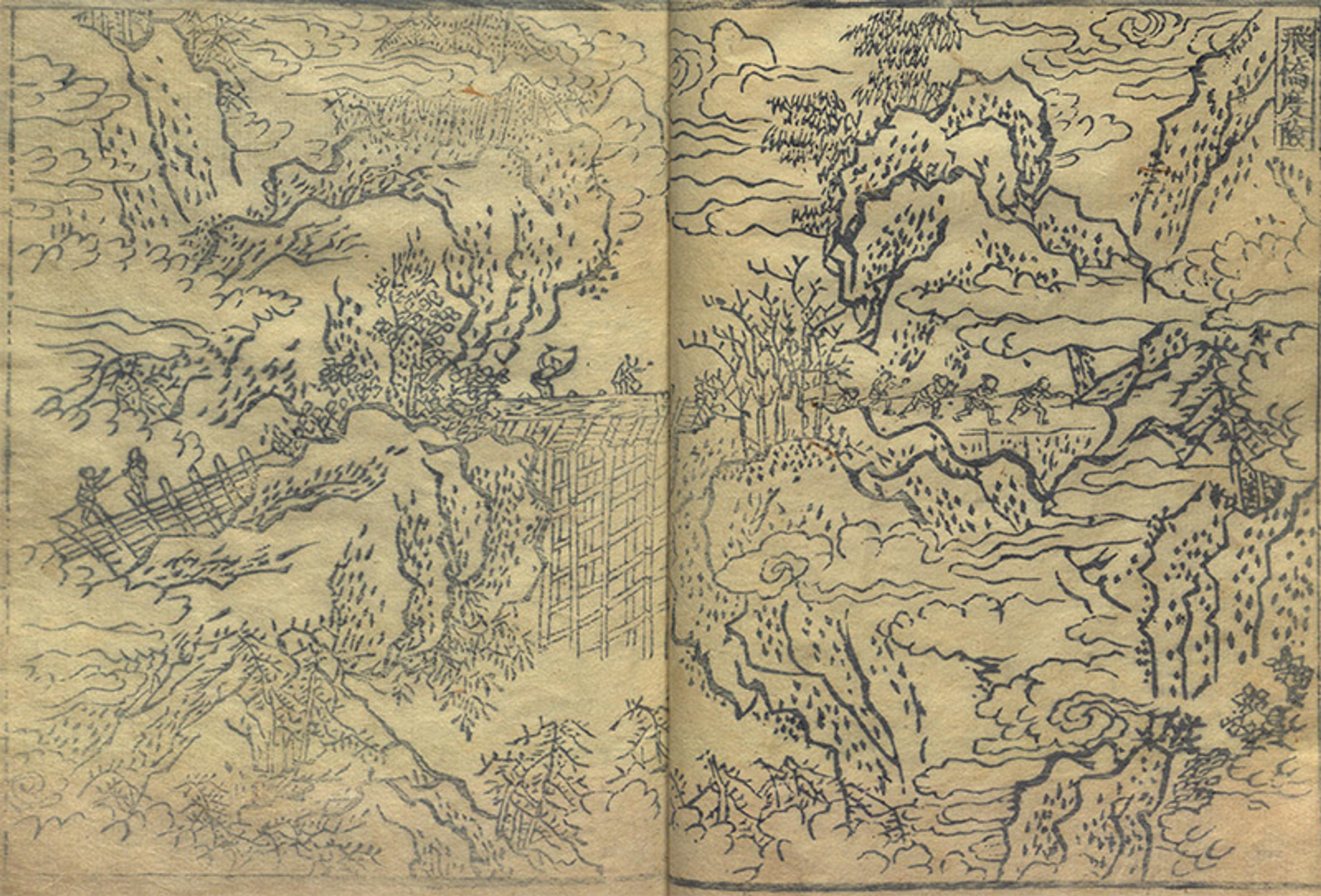
Logging of nanmu timber in southwest China; a flying bridge. Images courtesy the Library of Congress
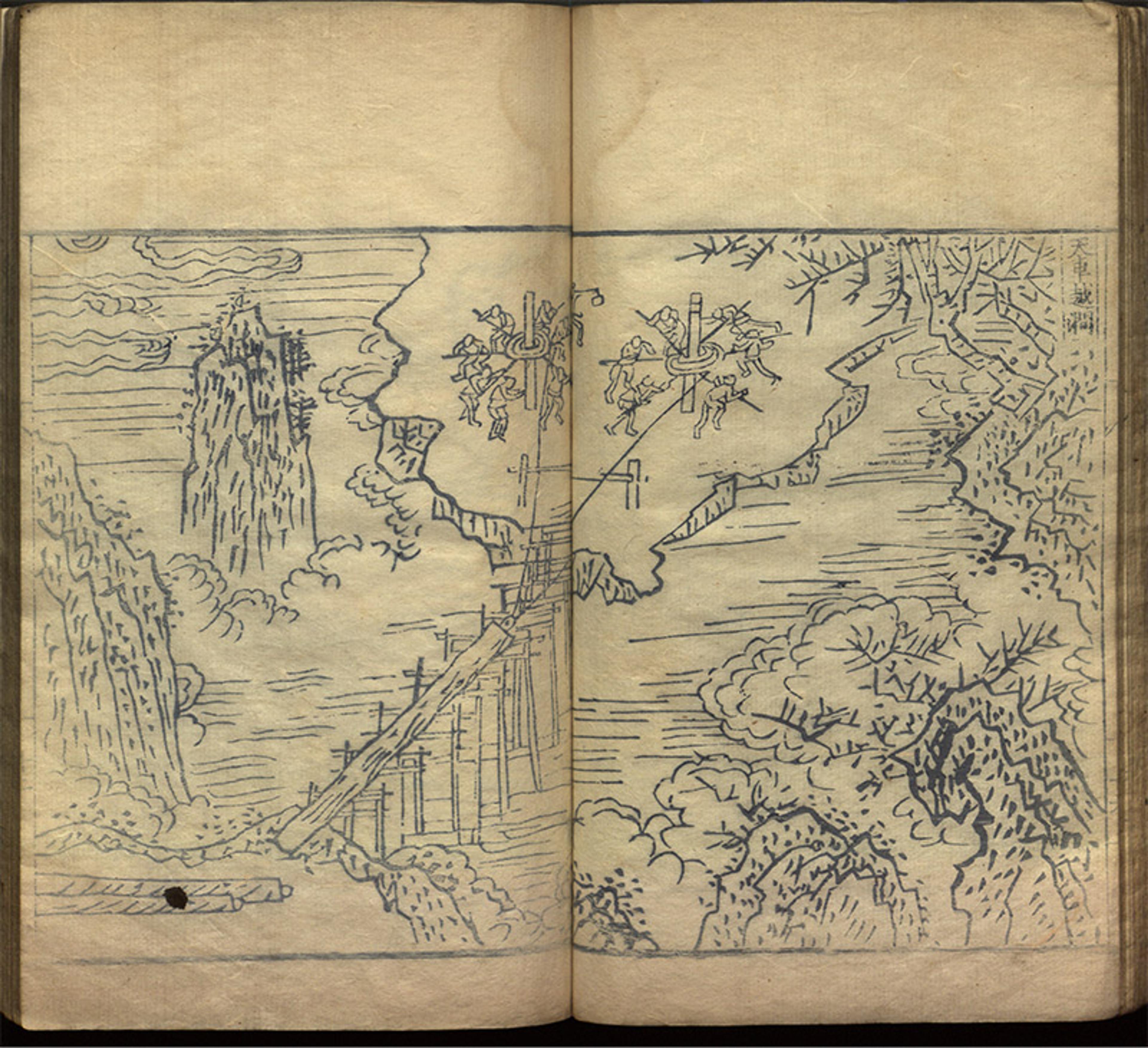
Dragging logs
Standardisation continued over time. In the 17th century, a new formula calculated timber prices based on the estimated volume of an idealised conic log. These formulas were developed by Guo Mingzhu, the eldest daughter of a timber merchant, and only later adopted by the state, which used them until the 1950s. In 18th-century Fujian, another set of standards divided fir logs into four grades with colourful names like ‘big lucky wood’ (daji mu; 大吉木) and ‘high-seas wood’ (gaoyang mu; 高洋木). Officials compiled dimensions and processing instructions for each part of each grade of warship, providing specifications to the sawyers, joiners, caulkers and painters working the wood, and recording worker-days to two decimal places of precision.
Yet shipyard specifications belied the far more complex reality of obtaining timber, not to speak of the conditions in which the trees grew. Most conifers – including the ever-present fir – were grown on plantations. Most broadleaf hardwoods – including camphor, nanmu and ironwood – were not. Fast-growing species that thrived in cleared land and tolerated human interventions in their life cycles worked well as tree crops. Slower-growing species, or trees that preferred shade and responded poorly to disturbance, could reliably be cut only from natural-growth forests, often forests of substantial age. Yet both types of tree communities were in relationships with human communities, they were just different kinds of relationships. Let us start by considering the fir plantation.
The alliance between fir and foresters was one of the most successful trans-species partnerships
The China fir is actually not a close relative of true firs (Abies species). Its Latin name – Cunninghamia lanceolata – derives from an English botanist who spent only a short time in the region. In China, where it is the dominant timber tree south of the Yangtze, it is classified using the same term – shan; 杉 – also used for true firs, and for several other structurally similar conifers. For these reasons, I prefer to simply call it ‘fir’. Like several other small genera of conifer, it diverged from the rest of its family in the early Jurassic, and survived the ice ages in southern China’s minimally glaciated river valleys. While the earliest human interactions with the species are opaque to history, it is likely that firs were grown on small estates by the 1st millennium CE. But it was in the 2nd millennium that humans created a new set of relations with the tree.
The 11th and 12th centuries in China witnessed a growing pace of urbanisation, trade and some of the largest-scale naval warfare to that point in history. These dynamics drove up demand for timber, and southern landowners began planting firs in larger numbers. In 1149, a new policy allowed them to claim these trees as their permanent property by surveying the uneven boundaries of plots rather than calculating their area through a simple rectilinear formula. In some areas, registered acreage doubled almost overnight, most of the new area representing forest plantations. By the mid-1500s, mountainous areas across four southern provinces featured substantial acreage of taxable forests, most of which were tree plantations. By the late 18th century, fir trees spread into the upper reaches of the Yangtze River, the smaller watersheds draining to the southeast coast, and northern portions of the Pearl River watershed. The fir tree is now so widespread throughout this region that it is nearly impossible to determine its point of origin.
Given the rapid spread of plantations across southern China, we might see the alliance between fir and foresters as one of the most successful trans-species partnerships of the past millennium. But other features of the relationship call this conclusion into question. It turns out that China fir sprouts new shoots from the trunk of a cut tree – a rare feature among conifers. These slips, transplanted across the landscape to this day, are clones rather than sexual offspring of their mothers. Because the lifetime of plantation-grown firs is often as short as 30 years, they are not just clones, but young clones. Many tree plantations were managed corporately, with shareholders buying and selling the rights to future timber harvest. To shareholders, clonal, rapid-maturing firs were the ideal, fungible investment. But this raises the question: was the multi-province assemblage of fir plantations an interspecies alliance or a clone army of child-soldiers? And indeed, if fir clones were the perfect foot soldiers for southern China’s early corporate overlords, what relationships defined the interactions between people and the other trees that ended up dockside?
Let us turn next to nanmu (楠木), a broadleaf evergreen native to the Yangtze River’s interior tributaries. To builders, nanmu was, in many ways, a superior version of fir. It grew straight and tall, relatively quickly, and featured a particularly attractive grain when cut. Unlike fir, nanmu does not appear to have been planted on any scale. The logs floated out of the mountains and grew to maturity in mixed forests featuring many other species of plants and animals, including humans. But unlike the early fir-planters, these people were generally not full-time farmers. Instead, they depended on a mix of small-scale farming, hunting, gathering and herding. Nanmu is now widely used as a shrine tree throughout the region, and may have been venerated by many of these agro-silvo-pastoralists. They also traded forest products – including nanmu timber – with outsiders. Medieval Chinese records speak of ‘wood guests’ (muke; 木客) who came out of the mountains to trade timber for textiles and metal tools. Chinese merchants were to remain in the river valleys and allow their counterparts to transport the trees out of the mountains.
The story of nanmu took a sharp turn in the late 14th century, when the armies of the Ming dynasty pursued a Mongol prince into the upper reaches of the Yangtze River watershed. This area had been integrated into the Mongol empire in the 13th century, but largely ruled by ‘native officials’ (tuguan; 土官). As Ming armies penetrated the region to remove this rival, they likewise granted titles to non-Han rulers, recognising a degree of Indigenous sovereignty as long as these native officials in turn recognised the authority of Beijing. Part of this relationship entailed presenting timber to the court, at first on a relatively small scale. Then, in 1406, the third Ming emperor, Zhu Di, greatly scaled up the extraction of tribute. A junior son of the dynastic founder, Zhu Di had deposed his nephew to seize the throne, and had few compunctions about projecting power into the borderlands. He sent dozens of officials and thousands of forced labourers to cut and ship hundreds of thousands of nanmu trunks to Beijing. There, he built palaces on an unprecedented scale, entombing the majesty of ancient trees in lacquer and erecting them to support the enormous roofs of the Forbidden City.
Just a few large trees could purchase a promotion
This scale of logging could not be maintained and, after Zhu Di died, the expeditions were cancelled. But when palaces burned down in the 16th century, logging was reopened. Logging supervisors looked everywhere for nanmu: the estates of imperial princes, the graveyards of prominent families, mountains at less cultural and geographic distance from Beijing. They complained constantly of the conditions at the frontier: malaria, attacks by Indigenous groups, starvation, and the extreme difficulty of extracting enormous trees from their remote mountain homes. But, more than anything, they relied on timber tribute. Indigenous rulers could submit timber – valued at 3,000 silver taels for the highest-ranking ‘pacification commissioners’ – in exchange for promotion and elaborate regalia, including the four-clawed dragon (mang; 蟒) that represented the highest rank given to people outside the imperial family. This was, in essence, a ‘trees-for-titles’ scheme.
Timber tribute probably represented the top end of the nanmu marketplace, a market that also supplied timber for shipbuilding. Based on modern data on nanmu growth rates, trees of six-foot circumference – the largest grade used at the shipyards – would have been about a century old, and worth about two silver taels. But extrapolating to larger sizes, a 12-foot-circumference log from a 200-year-old tree might be valued at 70 taels or more. Just a few large trees could purchase a promotion, while nanmu of lesser size could be sold to the merchants who supplied the shipyards.
While trees-for-titles offered the court a way to lessen the expense of palace-building, it also initiated an unsustainable competition among the native potentates. Several times, the granting of mang robes to one ruler inspired his or her rivals (there were several female rulers in the region) to a spate of violent competition to find and log the best remaining nanmu. The most extreme case came in the 1590s, when Yang Yinglong, ruler of the Bozhou Pacification Commission, raised an army said to number 140,000 soldiers. Ultimately, Yang’s army was defeated by an even larger force, he immolated himself rather than face capture, and his domain was integrated under direct Ming control. While there were multiple overlapping factors leading to his uprising – including a conflict over sending troops to fight Hideyoshi in Korea – the timber tribute was clearly significant. Long after Yang Yinglong’s death, the descendants of his former subjects venerated him for protecting them from Beijing’s excessive demands.
The Bozhou uprising represented the beginning of a violent period in southwestern China lasting nearly a century. But as soon as the Qing dynasty established control in 1681, they ordered officials back into the mountains to cut timber. These officials soon reported that the largest trees were gone, or unreachable from the rivers. As the historian Meng Zhang has shown, timber tribute was then transformed into a system of licenses granting merchants the first choice of timber on the market, but, unlike in the Ming, the only species specifically noted in the tributary regulations was fir. Supplying timber tribute to the court was nonetheless a money-losing proposition, so compradors were allowed to underwrite their official business by buying and selling their own logs on the side.
Meanwhile, the Indigenous settlements of southwestern China – including people now identified as Miao, Yi and members of several other ethnic groups – were increasingly beset by settlers from the lowlands of eastern China. By 1700, the largest native offices had largely been eliminated; in the following decades, the Qing targeted the ‘Miao frontier’, one of the last large areas resisting direct control from Beijing. By the late 18th century, Miao villagers in eastern Guizhou began to plant fir trees to make up a growing share of their timber exports. To prevent interethnic violence, Beijing granted several Miao towns a joint monopoly on timber sales out of the region, a position they defended well into the 19th century. Further west, in the lands of the Nasu and Nuosu people, uprisings likewise led Beijing to establish ethno-ecological frontiers between Chinese settlers in the lowlands and non-Han groups in the uplands. But increasingly, the fringes of Sichuan, Yunnan and Guizhou began to look more like eastern China, with dense agriculture in the river valleys, and fir-based silviculture extending to the lower slopes of mountains. The distinct agro-silvo-pastoral lifeways that had protected, venerated and logged nanmu from old-growth forests were on the decline.
Now let us turn to a tree native to a region south of the nanmu heartland: ironwood (Mesua ferrea – tielimu; 鐵力木). In Guangdong and Guangxi, ships built almost entirely of ironwood were renowned for their durability. Outside this region, ironwood was rare enough that it was mostly used for ships’ rudders. By the mid-1500s, a tariff station was established on the West River to tax ironwood as it came out of Guangxi. Like fir and nanmu, ironwood was graded in standard sizes ranging from one to two poles long and one to six feet in circumference. Like Yunnan and Guizhou, much of 16th-century Guangxi was controlled by Indigenous potentates, known to Beijing as ‘native officials’, so it is possible that the ironwood trade was comparable with the nanmu timber tribute, although the state of research is currently hazy.
The ironwood tree population suffered in the face of rampant logging; its decline was even more precipitous than that of nanmu. In the 1530s, an ironwood-planked ship cost 500 silver taels; by the 1570s, the price had doubled, even as the cost of fir ships remained roughly constant. It grew so scarce that, in 1629, officials were dispatched to Vietnam to buy just two poles of ironwood; in 1663, another group of buyers found it only on a Dutch ship coming from Southeast Asia. As shipyard officials reported greater difficulties obtaining ironwood at market, gazetteers show a clear decline in the availability of these trees in the interior. In the early 1600s, Yangchun County in Guangdong had ‘lots of ironwood’ but, by the turn of the 18th century, it reported ‘a little ironwood … but none that fills an arm span; if you want larger materials, they can only be found in Guangxi.’ Other counties that previously exported ironwood simply reported that ‘there is no longer any ironwood’ or ‘ironwood is now rare.’ By the late 1750s, Pehr Osbeck, a Swedish botanist and disciple of Carl Linnaeus, reported that anchors were still made of ironwood, but Cantonese ships were now planked with fir. By the 20th century, even rudders were made from lychee or camphor. As of 2007, ironwood was so rare that the compilers of Flora of China considered it unlikely to be native to the region.
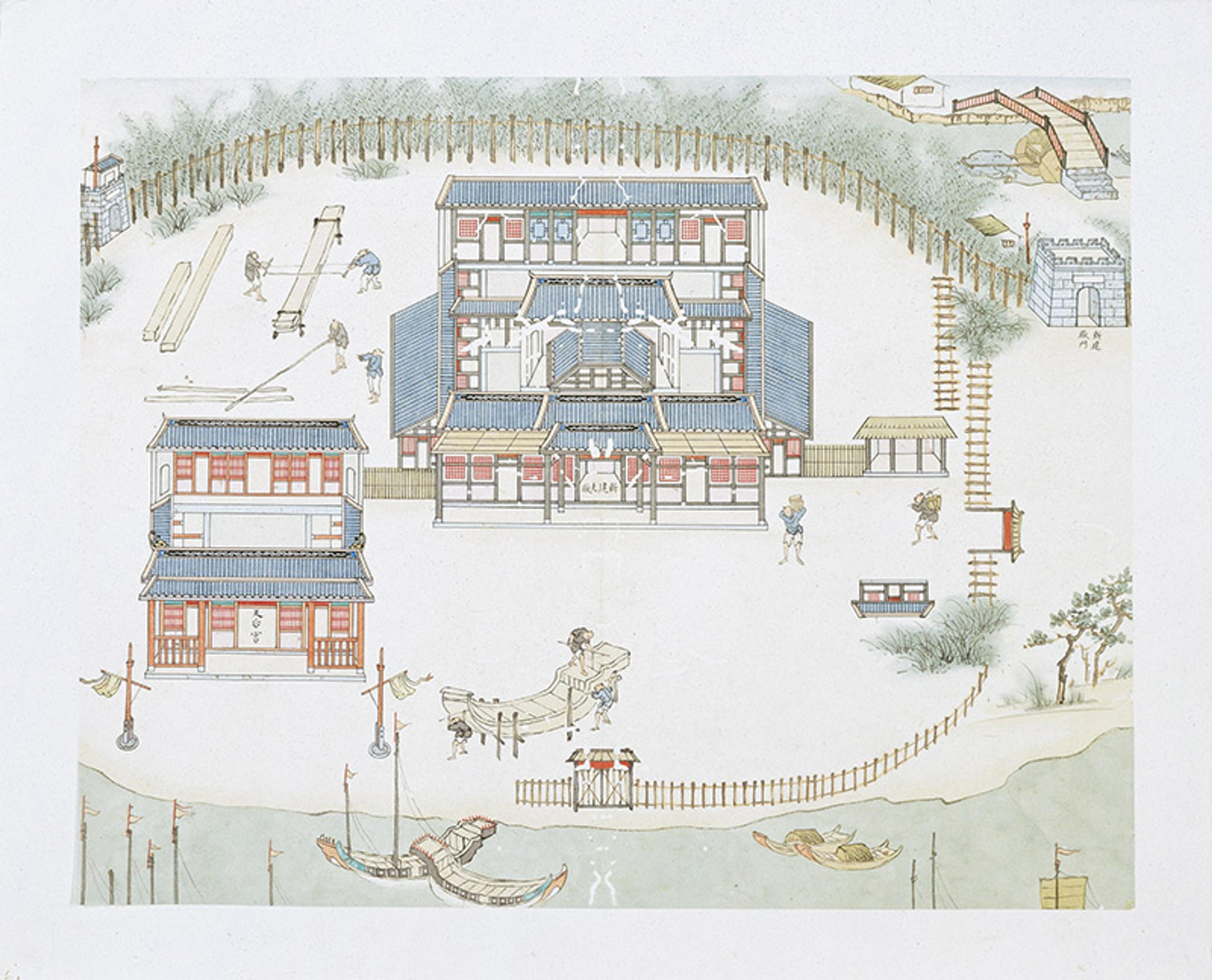
A shipyard in Taiwan. Courtesy the National Palace Museum in Taiwan
These three timbers from the Chinese interior – fir, nanmu and ironwood – were all used to build ships on the coast, including those that fought in the Qing-Zheng wars of the 17th century. Yet these wars themselves opened another front in the assault on the forests of Eastern Asia. In 1683, the Qing navy defeated the Zheng fleet’s ‘masts like a forest’ and seized control of Taiwan, or more properly, southwestern Taiwan – the rest of the island was inhabited by a variety of Indigenous groups who relied primarily on hunting and gathering. As the Qing solidified control of the island, 18th- and 19th-century Taiwan came to feature its own system for supplying timber to the shipyards. Two generations after the Qing conquest, in 1722, the government established a line of 514 stones to divide the western plains inhabited by Han Chinese farmers from the eastern mountains that were home to Indigenous Taiwanese hunters. Yet just three years later, the Qing built official shipyards in southwestern Taiwan, which required timber from the eastern interior, an area where logging was explicitly forbidden to Han settlers. The court’s solution was to establish another office, the ‘military works foreman’ (jungong jiangshou) with exclusive logging rights in Indigenous territory. As in the southwest, this system featured both a border between ethnic groups, and an institution that could cross the border to supply timber to the shipyards.
Gifts of rice, salt, wine, pigs, guns and gunpowder were exchanged for permission to log
While a variety of trees grew in Taiwan’s forests, its conifers were too deep in the mountains to be accessible to shipyard officials. In fact, Taiwan’s shipyards imported the fir and pine used for hulls and masts from the mainland. Instead, the foreman focused on the most-accessible desirable timber – camphor (Cinnamomum camphora), which grew in the hills just beyond the Han-Indigenous frontier, and was used to build cabins and the other upper structures of the ship. But, like the timber tribute in the southwest, supplying camphor timber to the shipyards was a money-losing proposition. To enable the office of works-foreman to pay for itself, the foremen were given a monopoly not only on timber, but on other forest products, including the highly profitable business of refining camphor hearts into terpene crystals used for medicine and ritual purposes: ‘All the camphor timber produced is purchased by the … materials office,’ noted one essay from the Danshui Gazetteer, ‘each furnace household that boils camphor in the mountains of the interior is also controlled by the materials office.’ If logging in 16th-century Sichuan and Guizhou operated under a ‘trees-for-titles’ system, Taiwan’s 18th- and 19th-century camphor monopoly was a ‘timber-for-terpenes’ arrangement.
Yet the military works-foreman represented only the Qing side of the trade. In addition to paying taxes to the official materials office, furnace households relied on intermediaries, often Indigenous people acculturated to Chinese ways, Han men married to Indigenous women, or their mixed-race offspring. These go-betweens negotiated ‘mountain fees’ with the less-acculturated Indigenous people of the interior, including gifts of rice, salt, wine, pigs, guns and gunpowder, in exchange for permission to log and make camphor crystals. As the historian Faizah Zakaria has written, shared feasting ‘made kin of potential enemies’. From one perspective, the Han-Indigenous border established in the early 18th century enabled both sides to negotiate to their own advantage. From another, the limited flow of goods allowed both the Qing state and Indigenous Taiwanese to frame the exchange in terms that they understood – the former as an official monopoly, the latter as kinship sealed with gift exchange.
From the perspective of the shipyards, fir, nanmu, camphor and ironwood were strategic goods.
But the wood that ended up sawn into boards and nailed into hulls did not begin its life as commodity timber – at least not all of it did. To be sure, most fir trees were cut as slips and planted in uniform plots alongside their clonal sisters, their express purpose to end their lives sawn into boards and nailed to a hull. But nanmu, camphor and ironwood – and dozens of other tree species – did not respond as happily to the pressures of forest clearance and plantation. Most of these trees began their lives in ancient woodlands below their parent trees, surrounded by mixed canopies of other species. Some were venerated by the human communities living in and around their forests, others were largely ignored until they were decades, or even hundreds of years old. But then, unforeseen and unprecedented demand drove people to search out the oldest and largest of these trees – the very individuals that would previously have been objects of worship – and fell them to make ships’ hulls and imperial temples.
Indigenous forests were targeted as resources for radical political campaigns
Perhaps because of this escalated demand, the 15th through 18th centuries saw the institutionalisation of an old practice: drawing lines between farm and forest, and between the domains of Chinese states and those of non-Chinese peoples. These were not impermeable borders. In every place where Beijing marked a frontier limiting Han colonisation, it also created an institution with the exclusive right to cross that frontier: the timber tribute, the military works-foreman. While less visible in the historical records, the parties on the other side of the border – whether Yang Yinglong in Bozhou, or Indigenous villagers in Taiwan – created their own systems for managing the trans-border exchange. For hundreds of years, these semi-permeable boundaries protected the lifeways of people who depended on the forest for hunting, gathering and shifting agriculture. They also protected the other species that inhabited these forests, including trees such as nanmu, camphor and ironwood.
In the 19th century, even the semi-permeable boundaries that provided some provisional level of protection for non-Han communities and wild-growth forests began to fall. Facing unprecedented pressures from Han settlers, Miao communities at the heart of the nanmu-growing region revolted against Beijing twice, in 1795-1806, and in 1854-73. Ethnic tensions in Guangxi and Guangdong, the former ironwood heartland, gave birth to the Taiping movement, a millenarian rebellion turned civil war that swept across much of southern China in the 1850s. In response to colonial pressures from Britain and Japan, the Qing opened the mountains of Taiwan to Han settlers in the late 1870s and ’80s, only to transfer the island to Japanese control in 1895, as spoils of the first Sino-Japanese War.
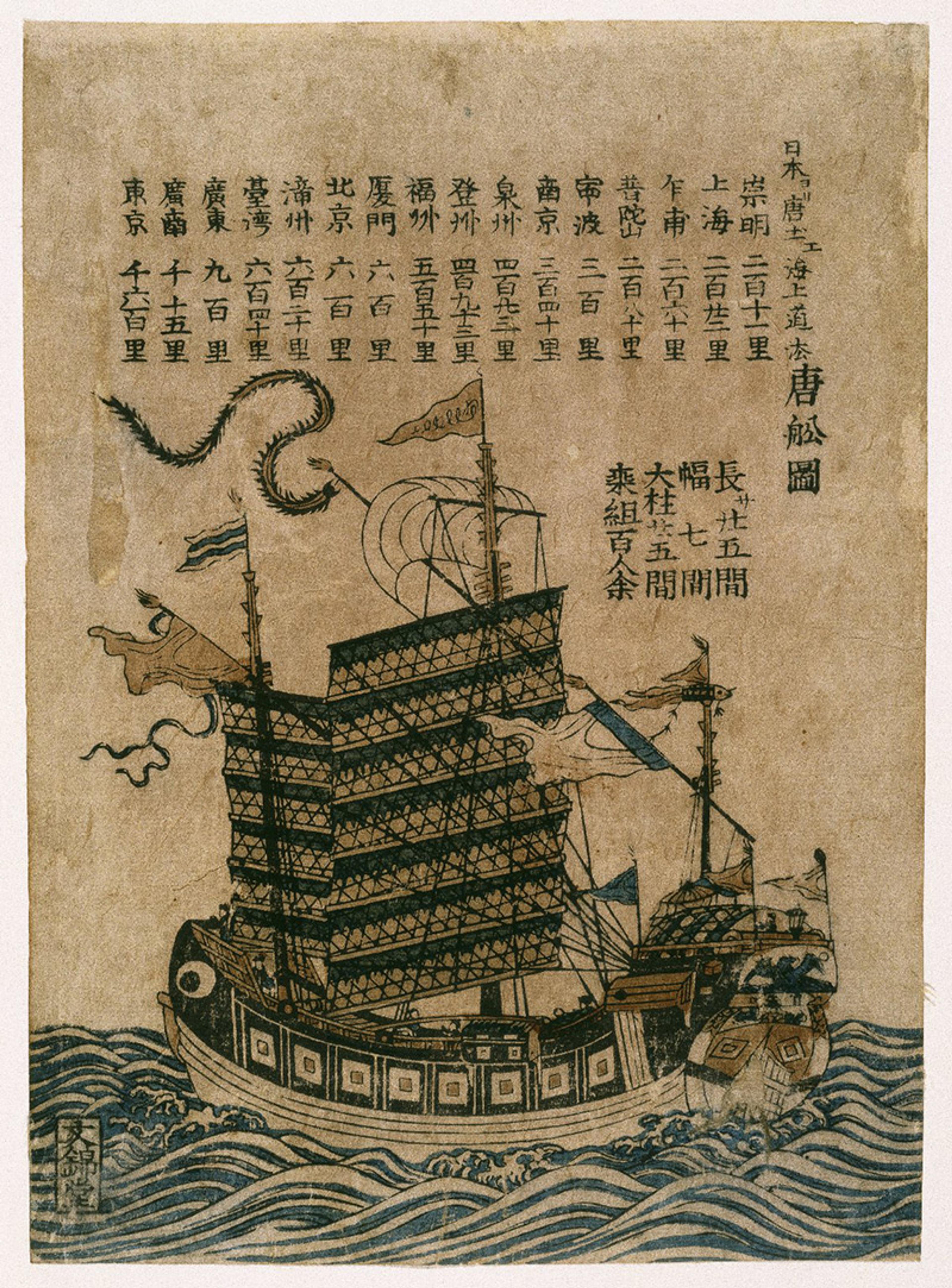
Chinese Ship (Tosen Zu) with Listing of the Sea Route from China to Japan (c1850). Courtesy the Brooklyn Museum
Over time, the Japanese Empire, and later the Republic of China (ROC, or Taiwan), worked to survey, classify and control both Indigenous forests and Indigenous people on the island. After a period of de facto independence following the fall of the Qing in 1912, the southwest faced another sometimes-violent recolonisation under the People’s Republic of China (PRC), its people surveyed and classified into the 56 official ethnic groups, its forests targeted as resources for radical political campaigns. It is only in the past few decades that both the PRC and the ROC have turned to new forms of conservation.
In the meantime, the importance of naval timber declined, as iron warships displaced wooden ones in national navies, and private Chinese shipbuilding moved to Southeast Asia, where both wood and labour were less expensive. States and corporations still value forests, but largely for different purposes – as plywood and laminates; paper pulp; chemical precursors; or to grow industrial crops such as rubber. Even structural timber is now valued more by its volume than the special characteristics of different tree species. The fates of the trees reflect both the old and new realities. Ironwood is now all-but-extirpated from China, except where reintroduced from Southeast Asia. Camphor grows patchily throughout an extensive territory, often as street trees or in temple complexes, but is far less prevalent in the broader landscape. Nanmu’s range is now a fraction of the territory formerly controlled by native offices in the middle and upper Yangtze River drainage. And fir – the clonal foot-soldier of merchants and empires – is everywhere.
